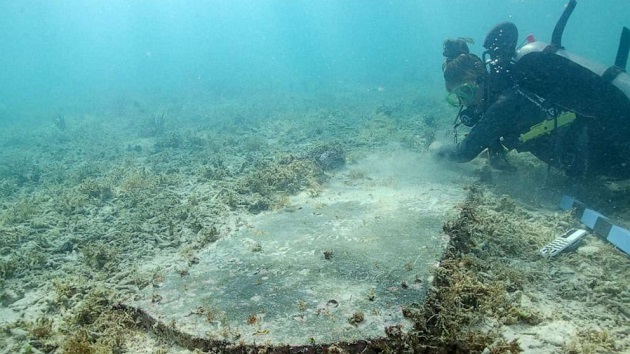(KEY WEST, Fla.) — The archeological remains of a 19th century hospital and cemetery have been found on a submerged island near Garden Key, the second-largest island in the Dry Tortugas National Park near Key West, Florida. The hospital served as a 19th century quarantine and cemetery for yellow fever patients between 1890 and 1900, according to the National Parks Service.
Historical records indicate that dozens of people, mostly U.S. soldiers stationed at Fort Jefferson, may have been buried at the cemetery, according to the NPS.
Dozens of people were interred in the Fort Jefferson Post Cemetery — most of them were military members serving or imprisoned at the Fort. Some civilians may have been buried there as well, historians said.
Only one grave has been identified, according to the NPS. A headstone in the underwater cemetery reads the name John Greer, who died while working at Fort Jefferson on Nov. 5, 1861.
The details surrounding Greer’s death are unclear, but his grave was prominently marked with a large slab of greywacke, the same material used to construct the first floor of Fort Jefferson, according to the NPS. It is inscribed with his name and date of death.
Historians are continuing to look for more information on Greer and other individuals interred on the now submerged island.
Fort Jefferson was mostly known for its use as a military prison during the American Civil War, but the islands and waters surrounding the fort were also used as a naval coaling outpost, lighthouse station, naval hospital, quarantine facility and safe harbor and military training, historians said.
The risk of deadly communicable diseases, particularly the mosquito-borne yellow fever, drastically increased as the population of Fort Jefferson increased with military personnel, prisoners, enslaved people, engineers, support staff, laborers and their families, according to the NPS. Major outbreaks of disease on the island killed dozens throughout the 1860s and 1870s.
As the population on Garden Key increased, several of the islands nearby were equipped with small structures for use as quarantine hospitals in the 1860s.
“The transfer of sick and dying patients to these small islands, isolated from the congested Fort Jefferson, likely saved hundreds from a similar fate,” the NPS said.
The use of many of the quarantine hospitals on the surrounding islands ceased after Fort Jefferson was abandoned in 1873, but the U.S. Marine Hospital Service required the development of an isolation hospital on one of the keys toward the end of the 19th century.
The discovery, conducted in August 2022 by several organizations, highlights the untold stories in Dry Tortugas National Park, “both above and below the water,” Josh Marano, maritime archeologist for the south Florida national parks and project director for the survey, said in a statement.
“Although much of the history of Fort Jefferson focuses on the fortification itself and some of its infamous prisoners, we are actively working to tell the stories of the enslaved people, women, children and civilian laborers,” Marano said.
The findings also highlight the impacts of climate change on resources in the Dry Tortugas, the NPS said.
The facilities were originally built on dry land, but dynamic conditions caused many of the islands to move over time, and climate change and major storm events have even caused some islands to settle and erode beneath the waves.
ABC News’ Dominick Proto contributed to this report.
Copyright © 2023, ABC Audio. All rights reserved.












